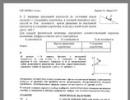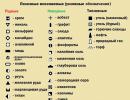Which seas do not mix and why. About all the knowledge of the sacred books or why the two oceans do not mix
Miracle of the Qur'an: the seas that do not mix
Sura 55 "The Merciful":
19. He mixed the two seas that meet each other.
20. There is a barrier between them that they cannot cross.
Sura 25 "Discrimination":
53. He is the One Who mixed two seas (types of water): one is pleasant, fresh, and the other is salty, bitter. He placed a barrier and an insurmountable obstacle between them.
While exploring the expanses of water in the Strait of Gibraltar, Jacques Cousteau discovered an amazing fact, not explained by science: the existence of two water columns that do not mix with each other. They seem to be separated by a film and have a clear boundary between them. Each of them has its own temperature, its own salt composition, flora and fauna. These are the waters of the Mediterranean Sea and the Atlantic Ocean touching each other in the Strait of Gibraltar.
“In 1962,” says Jacques Cousteau, “German scientists discovered that in the Bab el-Mandeb Strait, where the waters of the Gulf of Aden and the Red Sea converge, the waters of the Red Sea and the Indian Ocean do not mix. Following the example of our colleagues, we began to find out whether the waters of the Atlantic Ocean and the Mediterranean Sea mix. First we examined the water of the Mediterranean Sea - its natural level of salinity, density and the life forms inherent in it. We did the same thing in the Atlantic Ocean. These two masses of water have been meeting in the Strait of Gibraltar for thousands of years and it would be logical to assume that these two huge water masses should have mixed long ago - their salinity and density should have become the same, or at least similar. But even in the places where they converge closest, each of them retains its properties. In other words, at the confluence of two masses of water, the water curtain did not allow them to mix.”
When he discovered this obvious and incredible fact, the scientist was extremely surprised. “For a long time I rested on the laurels of this amazing phenomenon, inexplicable by the laws of physics and chemistry,” writes Cousteau.
But the scientist experienced even greater surprise and admiration when he learned that this was written about in the Koran 1,400 years ago. He learned about this from Dr. Maurice Bucaille, a Frenchman who converted to Islam.
“When I told him about my discovery, he skeptically told me that this was said in the Koran 1400 years ago. It was like a bolt from the blue for me. And indeed, this is how it turned out when I looked at the translations of the Koran. Then I exclaimed: “I swear that this Koran, from which modern science lags behind by 1400 years, cannot be the speech of man. This is the true speech of the Almighty.” After that, I accepted Islam and every day I was amazed at the truth, justice, ease, and usefulness of this religion. I am eternally grateful that He opened my eyes to the Truth,” Cousteau further writes.
Why do the waters of the Atlantic Ocean and the Mediterranean Sea not mix when they meet in the Strait of Gibraltar? Of the 23 groups studied in the Gulf of Alaska, 18 consisted of whales of similar sizes, and only the remaining 5 were of different sizes. The stomach of the sperm whale, like that of all toothed whales, is multi-chambered.
However, even in places where the waters converge closest, they nevertheless retain their properties, i.e. don't mix. How can they not mix if in both cases the solvent is water? Do not contradict the laws of thermodynamics! A photo with a sharp boundary does not mean anything, even if it is a photograph in the area of the strait, etc., it is simply a recording of some moment of mixing. This is called a halocline or salinity jump layer - a transitional boundary between waters of different salinity.
Most maps do not indicate the boundaries of the seas, so it seems that they simply smoothly pass into each other and into the oceans. The boundaries of the seas (or sea and ocean) are most clearly visible where a vertical halocline appears. A halocline is a strong difference in salinity between two layers of water. Jacques Cousteau discovered the same phenomenon while exploring the Strait of Gibraltar.
For a halocline to arise, one body of water must be five times saltier than another. In this case, physical laws will prevent the waters from mixing. Now imagine a vertical halocline that occurs when two seas collide, one of which has a salt percentage five times higher than the other. This is where you will see the place where the North Sea and the Baltic Sea meet.
They also cannot mix right away, and not only because of the difference in salinity. In other places, water boundaries also exist, but they are smoother and not noticeable to the eye, since the mixing of waters occurs more intensely. White_raccoon: it is at the Cape of Good Hope that the Atlantic and Indian currents meet. A wave that has passed the entire Atlantic can meet a wave that has passed through the entire Indian Ocean, but they will not cancel each other out, but will go further and reach Antarctica.
This is the mixing of the waters of the Gulf of Alaska with the open waters of the Pacific Ocean.
The sperm whale is a herd animal, living in large groups, sometimes reaching hundreds and even thousands of heads. It is distributed throughout the world's oceans with the exception of the polar regions. In nature, the sperm whale has practically no enemies; only killer whales can occasionally attack females and young animals.
Descriptions of the sperm whale are found in famous authors. Linnaeus cited two species of the genus Physeter in his work: catodon and macrocephalus. The weight of the “spermaceti sac” reaches 6 tons and even 11 tons. Behind the head, the body of the sperm whale expands and in the middle becomes thick, almost round in cross-section.
The border is outlined with a thin layer of foam.
When the sperm whale exhales, it produces a fountain directed obliquely forward and upward at an angle of approximately 45 degrees. At this time, the whale lies almost in one place, only moving forward a little, and, being in a horizontal position, rhythmically plunges into the water, releasing a fountain. The color often contains brown tones (especially noticeable in bright sunlight); brown and even almost black sperm whales are found. In the past, when sperm whales were more numerous, specimens weighing close to 100 tons were occasionally encountered.
Two harpoons belonging to the crew of the Anne Alexander were found in the sperm whale carcass.
The difference in size between male and female sperm whales is the largest among all cetaceans. The size of the heart of an average sperm whale is a meter in height and width. The sperm whale's spine has 7 cervical vertebrae, 11 thoracic, 8-9 lumbar and 20-24 caudal vertebrae. It consists of two main parts filled with spermaceti.
Back in the 1970s, studies appeared that showed that the spermaceti organ regulates the buoyancy of the sperm whale when diving and rising from the depths. However, both liquid and solid spermaceti are significantly lighter than water - its density at 30 °C is about 0.857 g/cm³, 0.852 at 37 °C and 0.850 at 40 °C.
Males are found over a wider range than females, and it is adult males (only they) that regularly appear in subpolar waters. Sperm whales are more common in warm waters than in cold ones. Leay, 1851), living in the northern and southern hemispheres, respectively. Whales of this stock stay off the Pacific coast of the United States all year round, but reach their maximum numbers in these waters from April to mid-November.

Hawaiian. During the summer and fall, this herd stays in the eastern Pacific Ocean
Its habitat is the Bering Sea, well separated from the main part of the Pacific Ocean by the ridge of the Aleutian Islands, which the sperm whales of this herd rarely cross. Most sperm whales can be found here in the fall in the waters of the New England continental shelf. Modern sperm whales appeared about 10 million years ago and, apparently, have changed little during this time, during which they have remained at the top of the ocean food chain.
The colossal pressure of water at depth does not harm the whale, since its body largely consists of fat and other liquids that are very little compressed by pressure. There are suggestions that the sperm whale uses echolocation not only to find prey and navigate, but also as a weapon. Thus, according to Soviet research, up to 28 species of cephalopods were found in the stomachs of sperm whales from the waters of the Kuril Islands (360 stomachs).
But female sperm whales were also very thoroughly killed in the years after World War II, especially in the waters washing the coasts of Chile and Peru
In the 1980s, it was estimated that sperm whales ate about 12 million tons of cephalopods per year in the waters of the Southern Ocean. A case is described in which a sperm whale was caught that had swallowed a squid so large that its tentacles did not fit in the whale’s belly, but stuck out and attached themselves to the sperm whale’s snout. An adult male sperm whale, with its enormous strength and powerful teeth, has no enemies in nature. There are different estimates of the current number of sperm whales in the World Ocean.
Sea pollution is an important factor influencing the number of sperm whales in a number of areas of the World Ocean.
Be that as it may, the number of sperm whales so far, especially in comparison with the number of other large whales, remains relatively high. The harvest of sperm whales was sharply limited in the second half of the 1960s, and in 1985, sperm whales, along with other whales, were completely protected.
According to some estimates, between 184,000 and 230,000 sperm whales were taken in the 19th century, and about 770,000 in the modern era (most of them between 1946 and 1980). All sperm whales were caught in the Northern Hemisphere. Before attacking the ship, the sperm whale managed to destroy two boats. Fortunately, there were no casualties, as the crew was rescued two days later. In 2004, data was published that from 1975 to 2002, sea vessels collided with large whales 292 times, including sperm whales 17 times. Moreover, in 13 cases, sperm whales died.
Jacques was impressed by the fact that this place was written about in the Koran 1,400 years ago. After this, he was attracted to the religion of Islam. The point here is surface tension: transport?r - what is the meaning of this word, in what language is it written? Here you can see a clear boundary between waters of different salinity.
Northern Gulf of Mexico herd. But, despite the spectacular border of these two seas, their waters gradually mix. Cousteau, having traveled a lot, discovered a place where the waters of the Mediterranean Sea and the Atlantic Ocean touch in the strait, without mixing with each other.
A not-so-rare phenomenon is a visible boundary between connected bodies of water: two seas, a sea and an ocean, a river and a tributary, etc. And yet, it always looks so unusual that you can’t help but wonder: why don’t their waters mix?
1. North Sea and Baltic Sea

The meeting point of the North Sea and the Baltic Sea near Skagen, Denmark. Water does not mix due to different densities.
2. Mediterranean Sea and Atlantic Ocean
3. Caribbean Sea and Atlantic Ocean

The meeting point of the Caribbean Sea and the Atlantic Ocean in the Antilles region.

The meeting place of the Caribbean Sea and the Atlantic Ocean on the island of Eleuthera, Bahamas. On the left is the Caribbean Sea (turquoise water), on the right is the Atlantic Ocean (blue water).
4. Suriname River and Atlantic Ocean
The meeting point of the Suriname River and the Atlantic Ocean in South America.
5. Uruguay River and its tributary

The confluence of the Uruguay River and its tributary in the province of Misiones, Argentina. One of them is cleared for agricultural needs, the other becomes almost red with clay during the rainy season.
6. Rio Negro and Solimões (Amazon section)
7. Moselle and Rhine

The confluence of the Moselle and Rhine rivers in Koblenz, Germany. The Rhine is lighter, the Moselle is darker.
8. Ilts, Danube and Inn



The confluence of the three rivers Ilz, Danube and Inn in Passau, Germany. Ilts is a small mountain river (in the 3rd photo in the lower left corner), the Danube in the middle and the Inn of a light color. Although the Inn is wider and deeper than the Danube at its confluence, it is considered a tributary.
9. Alaknanda and Bhagirathi

The confluence of the Alaknanda and Bhagirathi rivers in Devaprayag, India. Alaknanda is dark, Bhagirathi is light.
10. Irtysh and Ulba

The confluence of the Irtysh and Ulba rivers in Ust-Kamenogorsk, Kazakhstan. The Irtysh is clean, the Ulba is muddy.
11. Jialing and Yangtze

The confluence of the Jialing and Yangtze rivers in Chongqing, China. The Jialing River stretches for 119 km. In the city of Chongqing it flows into the Yangtze River. The clear waters of Jialing meet the brown waters of the Yangtze.
12. Irtysh and Om

The confluence of the Irtysh and Om rivers in Omsk, Russia. The Irtysh is muddy, the Om is transparent.
13. Irtysh and Tobol

The confluence of the Irtysh and Tobol rivers near Tobolsk, Tyumen region, Russia. The Irtysh is light, muddy, the Tobol is dark, transparent.
14. Chuya and Katun

The confluence of the Chuya and Katun rivers in the Ongudai region of the Altai Republic, Russia. The water of the Chuya in this place (after confluence with the Chaganuzun River) acquires an unusual cloudy white lead color and seems dense and thick. Katun is clean and turquoise. Combining together, they form a single two-color stream with a clear boundary and flow for some time without mixing.
15. Green and Colorado

Confluence of the Green and Colorado Rivers in Canyonlands National Park, Utah, USA. Green is green and Colorado is brown. The beds of these rivers run through rocks of different composition, which is why the colors of the water are so contrasting.
16. Rona and Arv

The confluence of the Rhone and Arve rivers in Geneva, Switzerland. The river on the left is the transparent Rhône, which emerges from Lake Leman. The river on the right is the muddy Arve, which is fed by the many glaciers of the Chamonix valley.
All seas and oceans and rivers on Earth communicate with each other. The water surface level is the same everywhere.
But you rarely see such a border. This is the border between the seas.
And the most amazing mergers are truly those where there is a visible contrast, a clear boundary between seas or flowing rivers.
North Sea and Baltic Sea

The meeting point of the North Sea and the Baltic Sea near the city of Skagen, Denmark. Water does not mix due to different densities. Locals call it the end of the world.
Mediterranean Sea and Aegean Sea

The meeting point of the Mediterranean Sea and the Aegean Sea near the Peloponnese Peninsula, Greece.
Mediterranean Sea and Atlantic Ocean

The meeting point of the Mediterranean Sea and the Atlantic Ocean at the Strait of Gibraltar. Water does not mix due to differences in density and salinity.
Caribbean Sea and Atlantic Ocean


Meeting point of the Caribbean Sea and the Atlantic Ocean in the Antilles region


The meeting place of the Caribbean Sea and the Atlantic Ocean on the island of Eleuthera, Bahamas. On the left is the Caribbean Sea (turquoise water), on the right is the Atlantic Ocean (blue water).
Suriname River and Atlantic Ocean
Meeting point of the Suriname River and the Atlantic Ocean in South America
Uruguay and tributary (Argentina)

The confluence of the Uruguay River and its tributary in the province of Misiones, Argentina. One of them is cleared for agricultural needs, the other becomes almost red with clay during the rainy season.
Gega and Yupshara (Abkhazia)


The confluence of the Gega and Yupshara rivers in Abkhazia. Gega is blue, and Yupshara is brown.
Rio Negro and Solimões (cf. Amazon section) (Brazil)

The confluence of the Rio Negro and Solimões rivers in Brazil.
Six miles from Manaus in Brazil, the Rio Negro and Solimões rivers join but do not mix for 4 kilometers. Rio Negro has dark water, while Solimões has light water. This phenomenon is explained by differences in temperature and flow speed. The Rio Negro flows at a speed of 2 kilometers per hour and a temperature of 28 degrees Celsius, and the Solimões at a speed of 4 to 6 kilometers and a temperature of 22 degrees Celsius.
Moselle and Rhine (Germany)


The confluence of the Moselle and Rhine rivers in Koblenz, Germany. The Rhine is lighter, the Moselle is darker.
Ilz, Danube and Inn (Germany)



The confluence of the three rivers Ilz, Danube and Inn in Passau, Germany.
Ilts is a small mountain river (in the 3rd photo in the lower left corner), the Danube in the middle and the light-colored Inn. Although the Inn is wider and fuller than the Danube at its confluence, it is considered a tributary.
Kura and Aragvi (Georgia)

The confluence of the Kura and Aragvi rivers in Mtskheta, Georgia.
Alaknanda and Bhagirathi (India)


The confluence of the Alaknanda and Bhagirathi rivers in Devaprayag, India. Alaknanda is dark, Bhagirathi is light.
Irtysh and Ulba (Kazakhstan)


The confluence of the Irtysh and Ulba rivers in Ust-Kamenogorsk, Kazakhstan. The Irtysh is clean, the Ulba is muddy.
Thompson and Fraser (Canada)


Confluence of the Thompson and Fraser Rivers, British Columbia, Canada. The Fraser River is fed by mountain waters and therefore has muddier water than the Thompson River, which flows through the plains.
Jialing and Yangtze (China)


The confluence of the Jialing and Yangtze rivers in Chongqing, China. The Jialing River, on the right, stretches for 119 km. In the city of Chongqing it flows into the Yangtze River. The clear waters of Jialing meet the brown waters of the Yangtze.
Argut and Katun (Russia)


The confluence of the Argut and Katun rivers in the Ongudai region, Altai, Russia. Argut is muddy, and Katun is clean.
Oka and Volga (Russia)


The confluence of the Oka and Volga rivers in Nizhny Novgorod, Russia. On the right is Oka (gray), on the left is Volga (blue).
Irtysh and Om (Russia)


The confluence of the Irtysh and Om rivers in Omsk, Russia. The Irtysh is muddy, the Om is transparent.
Cupid and Zeya (Russia)


The confluence of the Amur and Zeya rivers in Blagoveshchensk, Amur region, Russia. On the left is Cupid, on the right is Zeya.
Big Yenisei and Small Yenisei (Russia)

Confluence of the Greater Yenisei and the Lesser Yenisei near Kyzyl, Tyva Republic, Russia. On the left is the Big Yenisei, on the right is the Small Yenisei.
Irtysh and Tobol (Russia)


The confluence of the Irtysh and Tobol rivers near Tobolsk, Tyumen region, Russia. The Irtysh is light, muddy, the Tobol is dark, transparent.
Ardon and Tseydon (Russia)


The confluence of the Ardon and Tseydon rivers in North Ossetia, Russia. The muddy river is Ardon, and the light turquoise, clear river is Tseydon.
Katun and Koksa (Russia)


The confluence of the Katun and Koksa rivers near the village of Ust-Koksa, Altai, Russia. The Koksa River flows to the right, its water is dark in color. On the left is Katun, water with a greenish tint.
Katun and Akkem (Russia)


The confluence of the Katun and Akkem rivers in the Altai Republic, Russia. Katun is blue, Akkem is white.
Chuya and Katun (Russia)


The confluence of the Chuya and Katun rivers in the Ongudai region of the Altai Republic, Russia
The waters of the Chuya in this place (after the confluence with the Chaganuzun River) acquire an unusual cloudy white lead color and seem dense and dense. Katun is clean and turquoise. Combining together, they form a single two-color stream with a clear boundary, and for some time they flow without mixing.
Belaya and Kama (Russia)

The confluence of the Kama and Belaya rivers in Agidel, Bashkiria, Russia. The Belaya River is blue, and the Kama is greenish.
Chebdar and Bashkaus (Russia)


The confluence of the Chebdar and Bashkaus rivers near Mount Kaishkak, Altai, Russia.
Chebdar is blue, originates at an altitude of 2500 meters above sea level, flows through a deep gorge, where the height of the walls reaches 100 meters. The Bashkaus is greenish at the confluence.
Ilet and mineral spring (Russia)

The confluence of the Ilet River and a mineral spring in the Mari El Republic, Russia.
Green and Colorado (USA)


Confluence of the Green and Colorado Rivers in Canyonlands National Park, Utah, USA. Green is green and Colorado is brown. The beds of these rivers run through rocks of different composition, which is why the colors of the water are so contrasting.
Ohio and Mississippi (USA)

Confluence of the Ohio and Mississippi Rivers, USA. Mississippi is green and Ohio is brown. The waters of these rivers do not mix and have a clear boundary at a distance of almost 6 km.
Monongahela and Allegheny (USA)

The confluence of the Monongahela and Allegheny rivers joins the Ohio River in Pittsburgh Pennsylvania, USA. At the confluence of the Monongahela and Allegheny rivers they lose their names and become the new Ohio River.
White and Blue Nile (Sudan)

The confluence of the White Nile and Blue Nile rivers in Khartoum, the capital of Sudan.
Araks and Akhuryan (Türkiye)


The confluence of the Araks and Akhuryan rivers near Bagaran, on the Armenia-Türkiye border. On the right is Akhuryan (clean water), on the left is Araks (muddy water).
Rhone and Saone (France)

The confluence of the Saone and Rhone rivers in Lyon, France. The Rhone is blue, and its tributary the Saone is grey.
Drava and Danube (Croatia)

Confluence of the Drava and Danube rivers, Osijek, Croatia. On the right bank of the Drava River, 25 kilometers upstream from the confluence with the Danube, is the city of Osijek.
Rhone and Arv (Switzerland)


The confluence of the Rhone and Arve rivers in Geneva, Switzerland.
The river on the left is the transparent Rhône, which emerges from Lake Leman.
The river on the right is the muddy Arve, which is fed by many glaciers in the Chamonix valley.
They say that the Atlantic and Pacific oceans do not mix their waters. It is quite difficult for us to understand how identical liquids cannot combine. In this article “I and the World” will try to figure this out.
Of course, to say that the waters of the oceans do not mix at all is wrong. So why is the border between them so clearly visible? In the place where they touch, the direction of the currents is different, as well as the difference in the level of density of the water and the amount of salt in it. At the line of their intersection it is even clearly visible that the colors of the reservoirs are completely different. This joint is clearly visible in the photo.
The famous scientist Jacques Cousteau once spoke about the directions of currents, when the force of the earth at an angle to the axis of rotation prevents the waters from completely mixing at the place where they meet. But what’s interesting is that this phenomenon was written about in the Koran 1400 years ago.

The invisible merging of the oceans occurs only in the Southern Hemisphere, since in the Northern Hemisphere they are separated by continents.

Such clear boundaries can be seen not only where oceans meet, but also seas and between river basins. For example, the North and Baltic seas do not mix due to the different densities of their waters.

At the confluence of the Irtysh and Ulba, in the first river the water is clear, in the second it is muddy.

In China: the clean Jialing River flows into the brown-dirty Yangtze.

The two rivers, having traveled almost 4 km, still do not mix. This is explained by the different speeds of their currents and temperatures. The Rio Negro is slower and warmer, while the Solimões flows faster, but is cooler.


And there are many such examples. From the outside, all this seems mystical, until an exact explanation comes.
Video: the border where two oceans meet
If you liked interesting facts about places where the border between bodies of water is visible, share them with your friends. And, of course, subscribe to the “Me and the World” channel - it’s always interesting with us. See you again!










